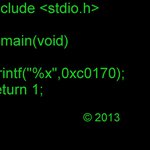The official Mbed 2 C/C++ SDK provides the software platform and libraries to build your applications.
Dependents: hello SerialTestv11 SerialTestv12 Sierpinski ... more
mbed 2
This is the mbed 2 library. If you'd like to learn about Mbed OS please see the mbed-os docs.
TARGET_RAPIDIOT_K64F/TOOLCHAIN_ARM_STD/fsl_gpio.h
- Committer:
- AnnaBridge
- Date:
- 2019-02-20
- Revision:
- 172:65be27845400
- Parent:
- 171:3a7713b1edbc
File content as of revision 172:65be27845400:
/*
* Copyright (c) 2015, Freescale Semiconductor, Inc.
* All rights reserved.
*
* Redistribution and use in source and binary forms, with or without modification,
* are permitted provided that the following conditions are met:
*
* o Redistributions of source code must retain the above copyright notice, this list
* of conditions and the following disclaimer.
*
* o Redistributions in binary form must reproduce the above copyright notice, this
* list of conditions and the following disclaimer in the documentation and/or
* other materials provided with the distribution.
*
* o Neither the name of Freescale Semiconductor, Inc. nor the names of its
* contributors may be used to endorse or promote products derived from this
* software without specific prior written permission.
*
* THIS SOFTWARE IS PROVIDED BY THE COPYRIGHT HOLDERS AND CONTRIBUTORS "AS IS" AND
* ANY EXPRESS OR IMPLIED WARRANTIES, INCLUDING, BUT NOT LIMITED TO, THE IMPLIED
* WARRANTIES OF MERCHANTABILITY AND FITNESS FOR A PARTICULAR PURPOSE ARE
* DISCLAIMED. IN NO EVENT SDRVL THE COPYRIGHT HOLDER OR CONTRIBUTORS BE LIABLE FOR
* ANY DIRECT, INDIRECT, INCIDENTAL, SPECIAL, EXEMPLARY, OR CONSEQUENTIAL DAMAGES
* (INCLUDING, BUT NOT LIMITED TO, PROCUREMENT OF SUBSTITUTE GOODS OR SERVICES;
* LOSS OF USE, DATA, OR PROFITS; OR BUSINESS INTERRUPTION) HOWEVER CAUSED AND ON
* ANY THEORY OF LIABILITY, WHETHER IN CONTRACT, STRICT LIABILITY, OR TORT
* (INCLUDING NEGLIGENCE OR OTHERWISE) ARISING IN ANY WAY OUT OF THE USE OF THIS
* SOFTWARE, EVEN IF ADVISED OF THE POSSIBILITY OF SUCH DAMAGE.
*/
#ifndef _FSL_GPIO_H_
#define _FSL_GPIO_H_
#include "fsl_common.h"
/*!
* @addtogroup gpio
* @{
*/
/*******************************************************************************
* Definitions
******************************************************************************/
/*! @name Driver version */
/*@{*/
/*! @brief GPIO driver version 2.1.1. */
#define FSL_GPIO_DRIVER_VERSION (MAKE_VERSION(2, 1, 1))
/*@}*/
/*! @brief GPIO direction definition */
typedef enum _gpio_pin_direction
{
kGPIO_DigitalInput = 0U, /*!< Set current pin as digital input*/
kGPIO_DigitalOutput = 1U, /*!< Set current pin as digital output*/
} gpio_pin_direction_t;
#if defined(FSL_FEATURE_GPIO_HAS_ATTRIBUTE_CHECKER) && FSL_FEATURE_GPIO_HAS_ATTRIBUTE_CHECKER
/*! @brief GPIO checker attribute */
typedef enum _gpio_checker_attribute
{
kGPIO_UsernonsecureRWUsersecureRWPrivilegedsecureRW =
0x00U, /*!< User nonsecure:Read+Write; User Secure:Read+Write; Privileged Secure:Read+Write */
kGPIO_UsernonsecureRUsersecureRWPrivilegedsecureRW =
0x01U, /*!< User nonsecure:Read; User Secure:Read+Write; Privileged Secure:Read+Write */
kGPIO_UsernonsecureNUsersecureRWPrivilegedsecureRW =
0x02U, /*!< User nonsecure:None; User Secure:Read+Write; Privileged Secure:Read+Write */
kGPIO_UsernonsecureRUsersecureRPrivilegedsecureRW =
0x03U, /*!< User nonsecure:Read; User Secure:Read; Privileged Secure:Read+Write */
kGPIO_UsernonsecureNUsersecureRPrivilegedsecureRW =
0x04U, /*!< User nonsecure:None; User Secure:Read; Privileged Secure:Read+Write */
kGPIO_UsernonsecureNUsersecureNPrivilegedsecureRW =
0x05U, /*!< User nonsecure:None; User Secure:None; Privileged Secure:Read+Write */
kGPIO_UsernonsecureNUsersecureNPrivilegedsecureR =
0x06U, /*!< User nonsecure:None; User Secure:None; Privileged Secure:Read */
kGPIO_UsernonsecureNUsersecureNPrivilegedsecureN =
0x07U, /*!< User nonsecure:None; User Secure:None; Privileged Secure:None */
kGPIO_IgnoreAttributeCheck = 0x10U, /*!< Ignores the attribute check */
} gpio_checker_attribute_t;
#endif
/*!
* @brief The GPIO pin configuration structure.
*
* Each pin can only be configured as either an output pin or an input pin at a time.
* If configured as an input pin, leave the outputConfig unused.
* Note that in some use cases, the corresponding port property should be configured in advance
* with the PORT_SetPinConfig().
*/
typedef struct _gpio_pin_config
{
gpio_pin_direction_t pinDirection; /*!< GPIO direction, input or output */
/* Output configurations; ignore if configured as an input pin */
uint8_t outputLogic; /*!< Set a default output logic, which has no use in input */
} gpio_pin_config_t;
/*! @} */
/*******************************************************************************
* API
******************************************************************************/
#if defined(__cplusplus)
extern "C" {
#endif
/*!
* @addtogroup gpio_driver
* @{
*/
/*! @name GPIO Configuration */
/*@{*/
/*!
* @brief Initializes a GPIO pin used by the board.
*
* To initialize the GPIO, define a pin configuration, as either input or output, in the user file.
* Then, call the GPIO_PinInit() function.
*
* This is an example to define an input pin or an output pin configuration.
* @code
* // Define a digital input pin configuration,
* gpio_pin_config_t config =
* {
* kGPIO_DigitalInput,
* 0,
* }
* //Define a digital output pin configuration,
* gpio_pin_config_t config =
* {
* kGPIO_DigitalOutput,
* 0,
* }
* @endcode
*
* @param base GPIO peripheral base pointer (GPIOA, GPIOB, GPIOC, and so on.)
* @param pin GPIO port pin number
* @param config GPIO pin configuration pointer
*/
void GPIO_PinInit(GPIO_Type *base, uint32_t pin, const gpio_pin_config_t *config);
/*@}*/
/*! @name GPIO Output Operations */
/*@{*/
/*!
* @brief Sets the output level of the multiple GPIO pins to the logic 1 or 0.
*
* @param base GPIO peripheral base pointer (GPIOA, GPIOB, GPIOC, and so on.)
* @param pin GPIO pin number
* @param output GPIO pin output logic level.
* - 0: corresponding pin output low-logic level.
* - 1: corresponding pin output high-logic level.
*/
static inline void GPIO_WritePinOutput(GPIO_Type *base, uint32_t pin, uint8_t output)
{
if (output == 0U)
{
base->PCOR = 1U << pin;
}
else
{
base->PSOR = 1U << pin;
}
}
/*!
* @brief Sets the output level of the multiple GPIO pins to the logic 1.
*
* @param base GPIO peripheral base pointer (GPIOA, GPIOB, GPIOC, and so on.)
* @param mask GPIO pin number macro
*/
static inline void GPIO_SetPinsOutput(GPIO_Type *base, uint32_t mask)
{
base->PSOR = mask;
}
/*!
* @brief Sets the output level of the multiple GPIO pins to the logic 0.
*
* @param base GPIO peripheral base pointer (GPIOA, GPIOB, GPIOC, and so on.)
* @param mask GPIO pin number macro
*/
static inline void GPIO_ClearPinsOutput(GPIO_Type *base, uint32_t mask)
{
base->PCOR = mask;
}
/*!
* @brief Reverses the current output logic of the multiple GPIO pins.
*
* @param base GPIO peripheral base pointer (GPIOA, GPIOB, GPIOC, and so on.)
* @param mask GPIO pin number macro
*/
static inline void GPIO_TogglePinsOutput(GPIO_Type *base, uint32_t mask)
{
base->PTOR = mask;
}
/*@}*/
/*! @name GPIO Input Operations */
/*@{*/
/*!
* @brief Reads the current input value of the GPIO port.
*
* @param base GPIO peripheral base pointer (GPIOA, GPIOB, GPIOC, and so on.)
* @param pin GPIO pin number
* @retval GPIO port input value
* - 0: corresponding pin input low-logic level.
* - 1: corresponding pin input high-logic level.
*/
static inline uint32_t GPIO_ReadPinInput(GPIO_Type *base, uint32_t pin)
{
return (((base->PDIR) >> pin) & 0x01U);
}
/*@}*/
/*! @name GPIO Interrupt */
/*@{*/
/*!
* @brief Reads the GPIO port interrupt status flag.
*
* If a pin is configured to generate the DMA request, the corresponding flag
* is cleared automatically at the completion of the requested DMA transfer.
* Otherwise, the flag remains set until a logic one is written to that flag.
* If configured for a level sensitive interrupt that remains asserted, the flag
* is set again immediately.
*
* @param base GPIO peripheral base pointer (GPIOA, GPIOB, GPIOC, and so on.)
* @retval The current GPIO port interrupt status flag, for example, 0x00010001 means the
* pin 0 and 17 have the interrupt.
*/
uint32_t GPIO_GetPinsInterruptFlags(GPIO_Type *base);
/*!
* @brief Clears multiple GPIO pin interrupt status flags.
*
* @param base GPIO peripheral base pointer (GPIOA, GPIOB, GPIOC, and so on.)
* @param mask GPIO pin number macro
*/
void GPIO_ClearPinsInterruptFlags(GPIO_Type *base, uint32_t mask);
#if defined(FSL_FEATURE_GPIO_HAS_ATTRIBUTE_CHECKER) && FSL_FEATURE_GPIO_HAS_ATTRIBUTE_CHECKER
/*!
* @brief The GPIO module supports a device-specific number of data ports, organized as 32-bit
* words. Each 32-bit data port includes a GACR register, which defines the byte-level
* attributes required for a successful access to the GPIO programming model. The attribute controls for the 4 data
* bytes in the GACR follow a standard little endian
* data convention.
*
* @param base GPIO peripheral base pointer (GPIOA, GPIOB, GPIOC, and so on.)
* @param mask GPIO pin number macro
*/
void GPIO_CheckAttributeBytes(GPIO_Type *base, gpio_checker_attribute_t attribute);
#endif
/*@}*/
/*! @} */
/*!
* @addtogroup fgpio_driver
* @{
*/
/*
* Introduces the FGPIO feature.
*
* The FGPIO features are only support on some Kinetis MCUs. The FGPIO registers are aliased to the IOPORT
* interface. Accesses via the IOPORT interface occur in parallel with any instruction fetches and
* complete in a single cycle. This aliased Fast GPIO memory map is called FGPIO.
*/
#if defined(FSL_FEATURE_SOC_FGPIO_COUNT) && FSL_FEATURE_SOC_FGPIO_COUNT
/*! @name FGPIO Configuration */
/*@{*/
/*!
* @brief Initializes a FGPIO pin used by the board.
*
* To initialize the FGPIO driver, define a pin configuration, as either input or output, in the user file.
* Then, call the FGPIO_PinInit() function.
*
* This is an example to define an input pin or an output pin configuration:
* @code
* // Define a digital input pin configuration,
* gpio_pin_config_t config =
* {
* kGPIO_DigitalInput,
* 0,
* }
* //Define a digital output pin configuration,
* gpio_pin_config_t config =
* {
* kGPIO_DigitalOutput,
* 0,
* }
* @endcode
*
* @param base FGPIO peripheral base pointer (FGPIOA, FGPIOB, FGPIOC, and so on.)
* @param pin FGPIO port pin number
* @param config FGPIO pin configuration pointer
*/
void FGPIO_PinInit(FGPIO_Type *base, uint32_t pin, const gpio_pin_config_t *config);
/*@}*/
/*! @name FGPIO Output Operations */
/*@{*/
/*!
* @brief Sets the output level of the multiple FGPIO pins to the logic 1 or 0.
*
* @param base FGPIO peripheral base pointer (FGPIOA, FGPIOB, FGPIOC, and so on.)
* @param pin FGPIO pin number
* @param output FGPIOpin output logic level.
* - 0: corresponding pin output low-logic level.
* - 1: corresponding pin output high-logic level.
*/
static inline void FGPIO_WritePinOutput(FGPIO_Type *base, uint32_t pin, uint8_t output)
{
if (output == 0U)
{
base->PCOR = 1 << pin;
}
else
{
base->PSOR = 1 << pin;
}
}
/*!
* @brief Sets the output level of the multiple FGPIO pins to the logic 1.
*
* @param base FGPIO peripheral base pointer (FGPIOA, FGPIOB, FGPIOC, and so on.)
* @param mask FGPIO pin number macro
*/
static inline void FGPIO_SetPinsOutput(FGPIO_Type *base, uint32_t mask)
{
base->PSOR = mask;
}
/*!
* @brief Sets the output level of the multiple FGPIO pins to the logic 0.
*
* @param base FGPIO peripheral base pointer (FGPIOA, FGPIOB, FGPIOC, and so on.)
* @param mask FGPIO pin number macro
*/
static inline void FGPIO_ClearPinsOutput(FGPIO_Type *base, uint32_t mask)
{
base->PCOR = mask;
}
/*!
* @brief Reverses the current output logic of the multiple FGPIO pins.
*
* @param base FGPIO peripheral base pointer (FGPIOA, FGPIOB, FGPIOC, and so on.)
* @param mask FGPIO pin number macro
*/
static inline void FGPIO_TogglePinsOutput(FGPIO_Type *base, uint32_t mask)
{
base->PTOR = mask;
}
/*@}*/
/*! @name FGPIO Input Operations */
/*@{*/
/*!
* @brief Reads the current input value of the FGPIO port.
*
* @param base FGPIO peripheral base pointer (FGPIOA, FGPIOB, FGPIOC, and so on.)
* @param pin FGPIO pin number
* @retval FGPIO port input value
* - 0: corresponding pin input low-logic level.
* - 1: corresponding pin input high-logic level.
*/
static inline uint32_t FGPIO_ReadPinInput(FGPIO_Type *base, uint32_t pin)
{
return (((base->PDIR) >> pin) & 0x01U);
}
/*@}*/
/*! @name FGPIO Interrupt */
/*@{*/
/*!
* @brief Reads the FGPIO port interrupt status flag.
*
* If a pin is configured to generate the DMA request, the corresponding flag
* is cleared automatically at the completion of the requested DMA transfer.
* Otherwise, the flag remains set until a logic one is written to that flag.
* If configured for a level-sensitive interrupt that remains asserted, the flag
* is set again immediately.
*
* @param base FGPIO peripheral base pointer (FGPIOA, FGPIOB, FGPIOC, and so on.)
* @retval The current FGPIO port interrupt status flags, for example, 0x00010001 means the
* pin 0 and 17 have the interrupt.
*/
uint32_t FGPIO_GetPinsInterruptFlags(FGPIO_Type *base);
/*!
* @brief Clears the multiple FGPIO pin interrupt status flag.
*
* @param base FGPIO peripheral base pointer (FGPIOA, FGPIOB, FGPIOC, and so on.)
* @param mask FGPIO pin number macro
*/
void FGPIO_ClearPinsInterruptFlags(FGPIO_Type *base, uint32_t mask);
#if defined(FSL_FEATURE_GPIO_HAS_ATTRIBUTE_CHECKER) && FSL_FEATURE_GPIO_HAS_ATTRIBUTE_CHECKER
/*!
* @brief The FGPIO module supports a device-specific number of data ports, organized as 32-bit
* words. Each 32-bit data port includes a GACR register, which defines the byte-level
* attributes required for a successful access to the GPIO programming model. The attribute controls for the 4 data
* bytes in the GACR follow a standard little endian
* data convention.
*
* @param base FGPIO peripheral base pointer (FGPIOA, FGPIOB, FGPIOC, and so on.)
* @param mask FGPIO pin number macro
*/
void FGPIO_CheckAttributeBytes(FGPIO_Type *base, gpio_checker_attribute_t attribute);
#endif
/*@}*/
#endif /* FSL_FEATURE_SOC_FGPIO_COUNT */
#if defined(__cplusplus)
}
#endif
/*!
* @}
*/
#endif /* _FSL_GPIO_H_*/
 mbed official
mbed official




